Chris Sauter: Pilgrimage
Doubt, Southwest School of Art; Faith and Reason, Blue Star Contemporary Art Museum; Shape of The Universe, Fl!GHT Gallery; Communion, St. Marks Episcopal Church; Saint Apophenia (the patron saint of pattern makers, fortune tellers, coincidence, the mentally ill and artists), wherever you can find her.
When you become troubled, you will be astonished.
— Jesus
Only a closed mind is certain.
— Dean Spanley

Chris Sauter, like Jesus, invites you to stick your hand in a hole. For Christ it was the piercing in his side that he offered Thomas to touch in order to prove his reality; Chris provides holes in a wall-mounted image. As if touching was believing: even if you accept the invitation, you can only go so far in before hitting the wall. The piece is Thomas, a large format Plexiglas-laminated photograph of a male torso perforated by thirty-three holes, one for each year in the life of you-know-who. Each hole was cut in the shape of an individual component needed to construct a microscope which sits nearby on a clear acrylic pedestal. Or, depending on your predilection for seeing what you want to see, you could say it floats on the pedestal (or maybe you just understand electrons—more on this later). The piece is based on Doubting Thomas, a theme in western art since the 5th century. This stream of images finds its source in a characterization perpetrated by whoever wrote or compiled the gospel of John, a book in the new testament from the first century written largely to refute the ideas put forth in the gospel of Thomas, which was suppressed and lost until it was discovered in Egypt in 1945. A comparison of the two books highlights one idea: John says what you need is somewhere else; Thomas says you already have it. Hence the suppression, just one of many reaches by those in charge to retain power on the road from light to, uh, less light. Adding a further twist—the image is installed in an art gallery, a place where the implied admonishment is Do Not Touch. This playfulness characterizes the show and is clearly at work in Soft Focus, a deep space photograph of the Hubble Telescope made blurry by a storm of fingerprints. Taken together these two works make the essential point: evidence is best examined from a perspective neither too close nor too far from the object of inquiry. So remember the naked eye as a corrective to the micro and the macro alike—and never forget that it’s all funny.
And so it came to pass that Chris Sauter’s Pilgrimage began at the Southwest School of Art with Doubt, a good state of mind in which to begin any investigation. This is the largest of the inter-related projects he has assembled to examine “the false dichotomies between religion and science.” The image that opens the show bears the same title. It is a photograph shot inside an airplane in flight with the word “doubt” written backwards on the window. This creates the illusion that it was written miraculously from outside the plane. The low-angle morning light casts a shadow of the word on the adjacent seat back, reversing the letters so that it reads correctly. And beyond this shadow of a doubt lies what I believe to be the truth—that Sauter’s ideas often begin with the flash of a simple, but lucid perception. I can imagine the glee with which he wrote those backwards letters, knowing exactly what the effect would be.
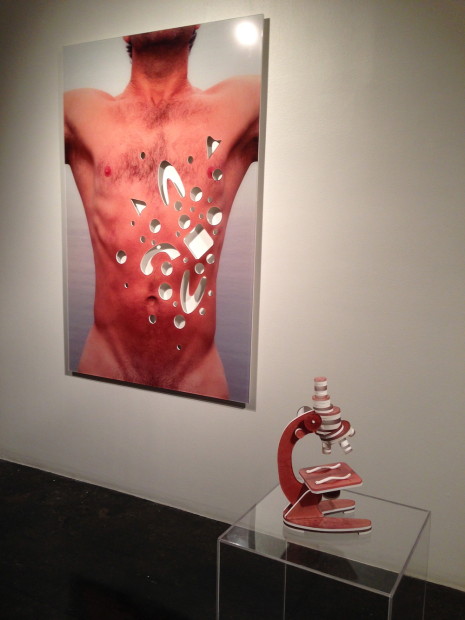
And so it continues. Space Station is a photo of the Hubble deep field from which an extremely detailed footprint of St. Peter’s Basilica has been carefully cut. The cut out is mounted next to the original photo and does indeed look like a space station, achieving an Erich von Däniken ta-da! effect. Who knew the famous church in Rome was actually a complex blueprint left by an alien race only to be appropriated by The Vatican? (Frankly, I’m not that surprised—I’ve seen with my own eyes the impression of an alien body in a stone at the base of a pillar in Chartres Cathedral.) Anyway, this tiny work Space Station finds a companion in the largest work in the show, a seven-by-fourteen free-standing stretched canvas, titled for the 1972 Andrei Tarkovsky film, Solaris. The screen is part edifice and part prop with a highly visible support structure for the surface upon which the undulating image of a planetary soup is projected, referencing the sentient ocean in the film. The Solarian ocean is beyond human comprehension and is capable of manifesting the thoughts and memories of the scientists who observe it from a research station orbiting above. The scale of Sauter’s piece necessarily puts one too close to the action for any sense of perspective to be possible—Solaris is once again found to be inscrutable. The source of Sauter’s video is footage he shot of algae in the pond outside the Bijou Theatre which he noticed after viewing Terence Malick’s Tree of Life a few years ago. The look of the algae reminded him of the Tarkovsky film and he uses it in the show projected at half speed to achieve the effect which mimics the gaseous atmosphere of Jupiter. Tarkovsky’s ocean was made with similar kids-in-the-kitchen ingenuity—he filmed acetone mixed with aluminum powder and dyes. Sauter’s moment with the algae in the pond was perhaps what in the new testament is called “praying without ceasing”—a vigilant awareness that is in tune with why Tarkovsky had a multi-film obsession with images of water in motion. Malick also frequently fills his films with such moments of lucid presence brought on by flashes of insight triggered by sudden and swift beauty.
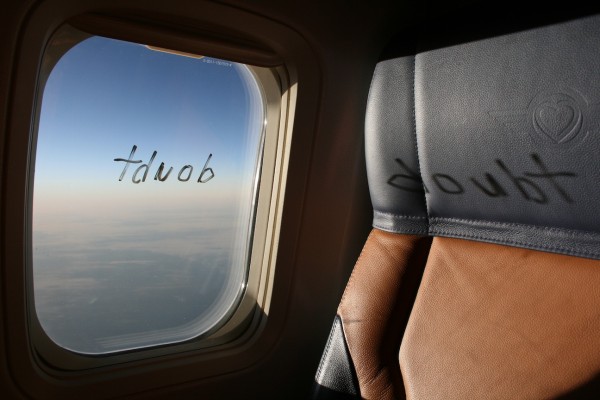
Space Station serves as the key connector to Shape of The Universe at FL!GHT Gallery. Titled for the ongoing cosmological debate, the show’s main attraction is four large plex-laminated photos circumscribing a square in the center of which is a gold-leafed telescope titled Reliquary. The photos are the same view of deep space, but each is cut into a specific shape representing the so called five major religions of the world: Kandariya Mahadeva Temple, India; Borubudur, Indonesia; The Dome of The Rock, currently Israel; and St. Peter’s Basilica, Italy. All are represented by aerially viewed outlines placing the viewpoint above the buildings, somewhere in the atmosphere, but not as far away as the Hubble deep space which each outline contains. But more to the point from the earthbound point of view is the fact that the four duplicate photographs are each shaped according to the eye of a hypothetical beholder representing Hinduism, Buddism, Judaism, Islam and Christianity. That there are five major religions but only four photos suggests the impossible: maybe the problem in Jerusalem can be solved by applying Heisenberg’s Principle of Uncertainty, which can be bent to assert that an object can be in two places at one time.
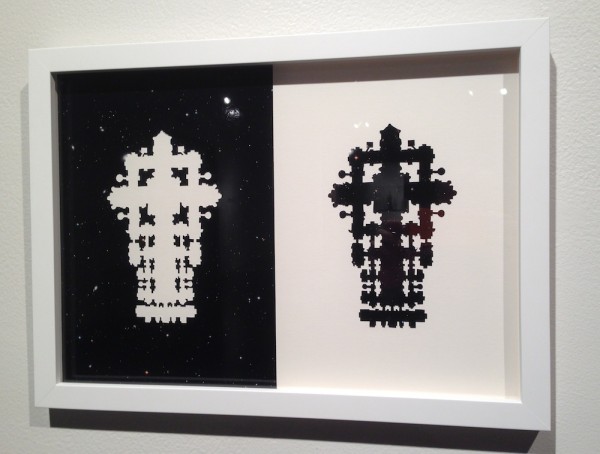
A second room at Fl!GHT contains a stack of books that includes a bible and bible dictionary along with books about astronomy, the big bang, human origins, the role of fire in human evolution, the history of the scientific revolution, the evolutionary basis of religion and the persistence of religion. The books appear to be stacked randomly, not according to geologically-themed layers, but in this context do read as sedimentary layers of human knowledge and expression. A tree worthy of Godot sits atop the stack and a tiny antennae in the tree strains to receive a signal or perhaps it is confidently humble, just waiting to pick up something, no more, no less. Yet another airplane window photo is mounted on a nearby wall. The word of choice this time is “desire,” perhaps indicative of the subjective bonds through which each of us colors everything we see, including the shape of the universe.
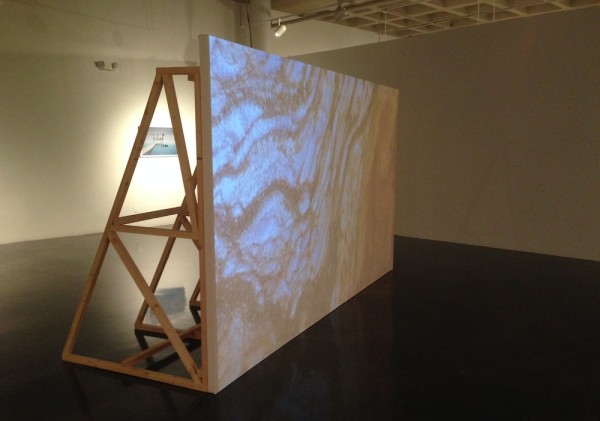
The Very Large Array, one of the world’s premier radio observatories is located in west-central New Mexico and has fascinated Sauter for more than three decades. Twenty-seven huge radio antennas moveable on a Y-shaped track combine to create the resolution of an antenna 22 miles in diameter. Construction was completed when Sauter was nine, his first visit was nine years later. It has been in his lexicon of images since and reappears at St. Mark’s Episcopal Church in downtown San Antonio as the fourth and final exhibition in the Pilgrimage series: Communion. For a model it is large scale, 36 inches across and built with an attention to detail worthy of the most obsessed miniature railroad freak; a beauty of careful, accurate, to-scale construction of wood and paper. It is placed on a base made to match exactly the woodwork of the tracery that criss-crosses the vaulted ceiling of the sanctuary, which is adjacent to the narthex—the entrance for the congregation and the thoughtfully planned destination for the piece. When it came time to install the piece, the church made a decision to put it by the back entrance—ironically, a concern about space was the issue—and there it sits in a tiny foyer, miss-matched with the mahogany woodwork, a low ceiling and a fire extinguisher, looking out of context and forgotten.

But back at the Southwest School of Art the puns keep piling up: Impact—a Newtonian reflector telescope-shaped meteorite that hit the earth on the day of Copernicus’ death in 1543; Asymmetry—a map of radiation assumed to be residue from the big bang lies on the floor. It includes colors indicating temperature fluctuations that correspond to the seeds that grew to become galaxies with the word “SACRED” cut out of it. It has fallen off the wall leaving the cut out letters still attached above. Problem is, “SCARED” is the word they spell; God of The Gaps—a church pew overturns the usual chair that is given in popular science explanations of how things are not really solid: You don’t really sit on a chair—you float an infinitesimal space above it because your electrons and the chairs electrons repel each other. Meanwhile, the artist has cut a few hundred holes in the pew (rendering it less than solid) and used the remaining circles to assemble a couple of giant carbon atom models that intersect parts of the back and seat. Carbon is the second most common element in the human body, second only to oxygen, but this abundance doesn’t translate to the pew on a human level—there is nowhere left to sit (as if you really could).
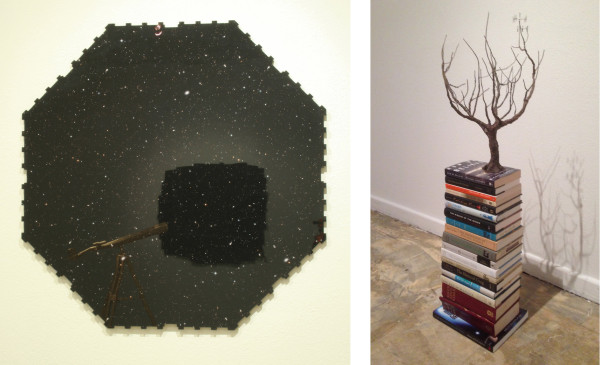
The artist’s meditation on perception and perspective is put into platitude form in Sacred Geometry, one of three felt banners on simple wooden stands that are made exactly like the churchy versions Sauter grew up with in Boerne, TX. These were made for this show by the artist’s parents who have in the past made biblical ones for their church. Composed of words superimposed on molecular structures, they appear to possess the guileless optimism of elementary school art projects. Sacred Geography’s helpful hint of the day is offered in contrasting phrases: “God of the Gaps” and “Devil in the Details,” balancing quantum physics on one side with a well known twentieth-century idiom on the other. The humor is subtle only because it might take awhile to see it—the yellow molecular drawings aligning with the quantum side have a unified look, while the devil’s connectors appear directionless and even get caught in feedback loops indicating the truth buried in the idiom—if you overlook or get bogged down in details you can get derailed. I expect this occurred to the artist more than once during the production of this ambitious set of projects. Another banner piece, Push and Pull, conflates “Holy Spirit” and “Dark Energy” on an atomic model that spells out “ETHER,” all under the painter’s vernacular of the title.

Some picture-plane play frames Belief System, another photo shot through an airplane window. The wing is visible, but the edges of the window are not. Instead the viewer looks through the glass of the picture frame upon which is scrawled in magic marker: “belief system.” The glass becomes the piece. The photo, that which is ostensibly there for your attention, is incidental. The point: it is the lens that determines what you see, more so than what you are looking at. Belief System and Doubt, the two airplane window photos installed at the Southwest School of Art are buttressed by eight other pieces in the series which are at The Blue Star Contemporary Art Museum under the title Faith and Reason. Three of them, Trust, Blind Faith and Arrogance, feature sunsets and speak in differing tones to the human tendency to assume that the sun always rises. Some of the other plane window photos didn’t speak to me, but in one of them, Denial, I did see a reflection, a trick of the light that looked exactly like Galileo.
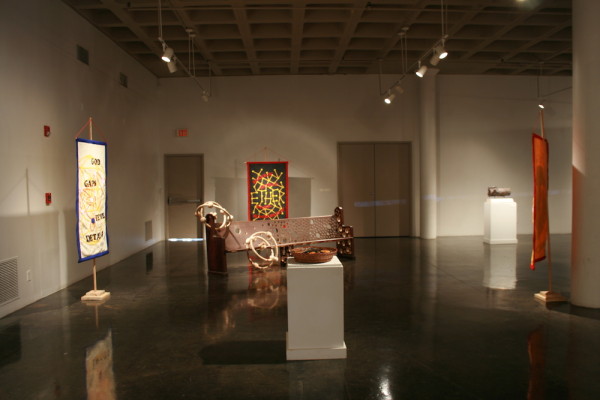
Sometimes scientific breakthroughs of the past sound incredibly obvious, like when it became understood that fossils do not grow in the ground. Nicolas Steno, to whom Sauter’s piece Stalagmite is dedicated, was among the first in the west to say that fossils came from living beings. He is also known for articulating some of the defining principles of geology, but again, sometimes these seem readily apparent with a certain “wheresoever thou goest, there shall ye also be” kind of logic. For example, Steno’s Principle of Cross-cutting Relationships, which states “If a body or discontinuity cuts across a stratum, it must have formed after that stratum.” Perhaps it is the accumulation of knowledge that we stand on that makes some discoveries of the past seem so simplistic. And apparently it is this accumulation that led Sauter to let thousands of candle drips build up on an open bible, mimicking the way that a stalagmite is formed while simultaneously acknowledging Steno’s geological insights—his work came a mere decade after Ussher’s preposterous chronology of the earth based on the bible which claimed that the planet came to be on October 23, 4004 B.C.E. (a Sunday). Or maybe all those drips are like tears, more tears than can be accounted for in Ussher’s timeline, including the ones shed by Steno because contemporaries like Kepler and Newton proposed histories that weren’t that far from what Ussher believed to be true. But no matter whose tears they are, there are plenty to go around as told in Ecclesiastes 4, the page of the bible obscured by wax in Stalagmite: “And behold the tears of the oppressed and they had no one to comfort them.”
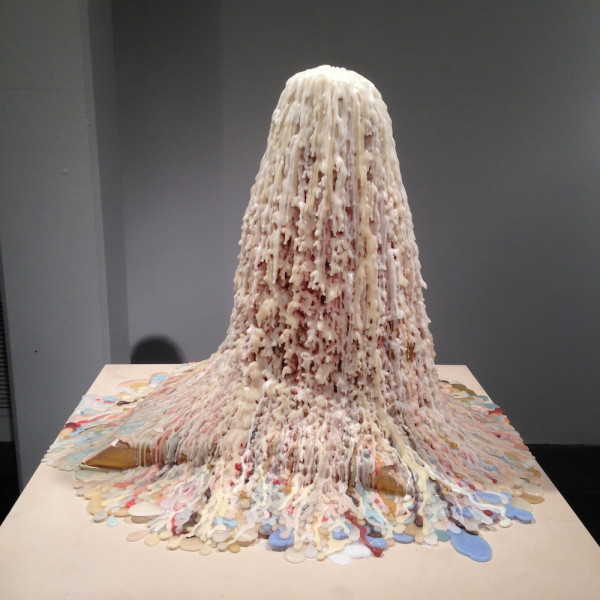
The votive offering motif recurs in Signal, a set of fifteen electronic candles presented on a traditional stand as found in a church. They flicker convincingly like real candles, but also get suddenly brighter in groups following a sequence representing the Arecibo message, which was sent in 1974 to a large star cluster that was judged to be close by (25,000 light years away). The pattern of the code is not discernible to a viewer in the gallery, but it is noticeable enough to be suggestive. The original message contained information about human numerical systems, atomic elements, DNA, the solar system, a pre-Disco outline of a human figure and a graphic with dimensions of the radio telescope in Arecibo, Puerta Rico from which the message was sent. Certainly enough information for the recipients to realize that they have been contacted by an intelligent species, but we can’t expect an answer any sooner than 51,935 years from now and that is if they answer immediately.
But who knows, they might sit on it.
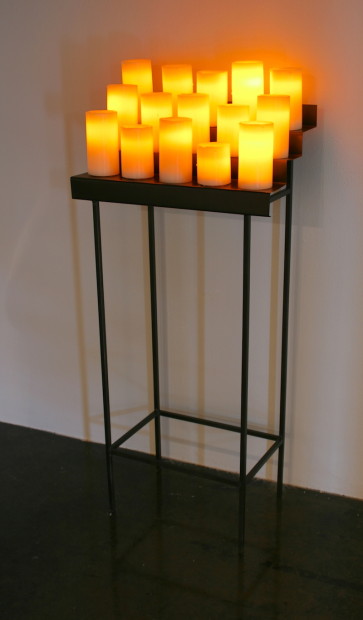
Chris Sauter‘s multi-venue tour de force, Pilgrimage, consists of the following four exhibitions:
Doubt, Southwest School of Art, Russell Hill Rogers Gallery I, Navarro Campus, November 21 – February 2, 2014;
Faith and Reason, Blue Star Contemporary Art Museum, December 5 – January 19, 2014;
Shape of The Universe, at Fl!GHT Gallery, through January 26;
Communion, St. Marks Episcopal Church, through January 29.
Hills Snyder’s writing is collected at U.S. 87: https://www.facebook.com/u


